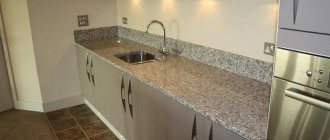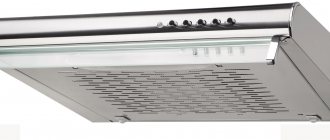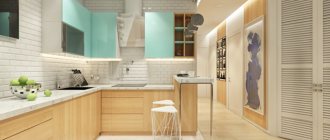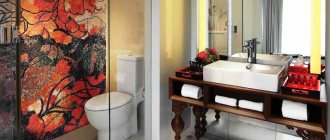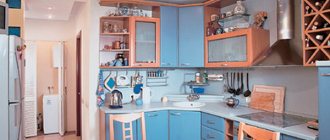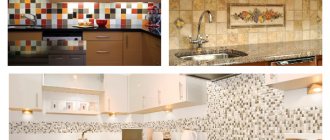SHARE ON SOCIAL NETWORKS
FacebookTwitterOkGoogle+PinterestVk
Due to its aesthetic appearance and unique properties, the undisputed leader in finishing materials is floor tiles for the hallway and kitchen: photos of modern interiors clearly demonstrate this. But how to choose the right tile among the many different offers on the market? Buying flooring is not an easy task that requires a careful approach to its solution. Indeed, to create not only a stylish, but also a high-quality interior, it is necessary to take into account the technical characteristics and features of this material. After reading the article and the proposed photos of floor tiles in the interior, you can easily make your own choice.
Ceramic tiles are one of the most practical types of flooring
Advantages and disadvantages of floor tiles
Tile has a number of advantages over other finishing materials:
- hygiene - tiles are considered the best finishing material for rooms with high levels of pollution. The smooth and even surface is easy to clean, does not accumulate dust and tolerates washing well even with the use of aggressive household chemicals. The latter is a big plus, since the floor in the kitchen and hallway is constantly exposed to moisture, which can contribute to the appearance of mold and harmful bacteria;
Floor tiles of different sizes and colors are used in the modern kitchen interior
- strength - with high-quality laying of tiles, it is able to withstand significant loads from impacts. In addition, it is not subject to mechanical damage and loss of color;
- durability – well-installed tiles can last you up to 50 years without losing their visual appeal;
- moisture resistance – not afraid of high humidity and even flooding;
The combination of black and white tiles is a timeless floor design option
- fire resistance - ceramic tiles do not react in any way to increased temperatures and will not burn in the event of a fire;
- ease of restoration - in case of damage there is no need to replace the entire floor covering. You can easily replace a separate section, returning the interior to its original appearance;
- environmental friendliness - ceramic tiles are a material that is safe for health;
Tiles with bright patterns will become an original interior decoration
- a large selection - numerous options for colors, patterns, sizes, as well as a variety of tile textures make it possible to create not only a practical, but also a visually attractive design.
Specialized online resources will help you get acquainted with a variety of photos of floor tiles for the hallway. Prices for this material can be found on the websites of construction stores.
Ceramic tiles are a durable material - their service life reaches 50 years
But, like any coating, tiles have a number of disadvantages. We list the difficulties associated with laying tiles and options for eliminating them:
- poor-quality installation can lead to cracks, so it is necessary to prepare a flat and dry base in advance;
- tiles have poor soundproofing properties. This drawback can be eliminated using a special layer, which is laid at the stage of creating the screed;
The most popular shapes of floor tiles are square and rectangle
- tile is a rather cold material. But at the same time, the tile has excellent thermal conductivity, so the problem can be solved by installing a “warm floor” system;
- tiles are a slippery surface, so it is better to give preference to tiles with a rough texture.
An example of using tiles in the interior of the hallway of a private house
Characteristics
According to EN ISO 13006 and GOST 6787-2001, there is a whole class of indicators that together determine the suitability of tiles for use in certain conditions. These include
Forming method and water absorption
Water absorption table.
Note that Russian glazed and unglazed floor tiles are produced only by pressing. Therefore, it is better for the kitchen to purchase domestic products with a protective glaze.
Bending resistance
This is the limiting value of the static load applied to 3 points of one element, which the test sample can withstand without destruction. Measured in N/mm² (ISO 1054-4 standard), for tiles it has the following minimum values:
| Tile category | Meaning |
| BIb | 27 |
| BIIa | 20 |
| Bllb | 16 |
That is, for example, kitchen tiles of category BIb can withstand loads of up to 270 kg/cm² or 27 MPa.
Surface hardness
This is the ability of a surface to be resistant to scratching and other damaging factors. Typically, the well-known MOHS mineral hardness scale is used. For glazed tiles, the optimal value is not lower than 5.
That is, the higher the indicator, the lower the risk of damage from falling objects, heels, animal claws, etc. A competent master will select flooring material with a surface hardness level of at least 6 units.
Resistance to temperature changes
This is the ability of good enamel not to crack or change during sudden changes in temperature (temperature shock). If you choose the wrong material, then due to drops of hot oil, boiling water or concentrated detergent hitting the surface, swelling or a network of small cracks may form at the contact point.
Chemical resistance
This parameter reveals the surface’s ability to withstand chemicals, including household chemicals, stain-forming liquids or products, salts, and acids. To determine this, a whole series of tests is carried out on the contact of the tiles and an aggressive environment.
| Class | Meaning |
| AA | According to the test results, there are no visible changes in appearance |
| A | After interaction, minor surface defects appear |
| IN | Changes after testing are average |
| WITH | Partial loss of original appearance |
| D | Complete loss of presentable exterior |
Frost resistance
This is the ability of a ceramic product not to collapse when immersed in water and cooled below 0 °C. It is measured by the number of freezing and thawing cycles and directly depends on the water absorption coefficient - the lower it is, the higher the frost resistance. Not relevant for interior spaces.
Abrasion resistance
This test for unglazed tiles is performed using cast silica (a synthetic abrasive). The value of the volume of the erased surface of the product obtained after testing allows us to assign a certain class of use to the tile according to UPEC. For glazed products, another indicator is used - PEI.
| Class | Meaning |
| P.E.I. | Operation with a minimum content of abrasive particles (bathrooms, bedrooms) |
| PEI II | Use in rooms with a small amount of abrasive components (offices, bedrooms, etc.) |
| PEI III | Use at an average level of abrasive particles (hallways, kitchens, cottage halls) |
| PEI IV | Installation in places of intensive use (canteens, shops, restaurants) |
| PEI V | Application in buildings with a high level of operational load (public places, industrial facilities) |
If you try to save money and put PEI I class tiles on your kitchen floor, you can rest assured that the coating will serve properly at best for about a year, or even less.
Slip resistance
This so-called safety criterion is not mandatory, but for some series of tiles it is considered necessary (swimming pools, locker rooms, public places, etc.), so manufacturers try to indicate the anti-slip coefficient on the packaging.
| Tilt angle, in ° | Group |
| 3-9 | R9 |
| 10-19 | R10 |
| 19-27 | R11 |
| 27-35 | R12 |
| >35 | R13 |
In fact, it would be a good idea to take this indicator into account if you plan to lay tiles in the hallway of a private house (without a “dressing room”) or the lobby of a public building. After all, in winter, snow that sticks to shoes quickly melts in the warmth. And it is very easy to slip on the puddles that form. This problem is especially typical for glossy tiles with a polished surface. Matte products in this regard are safer in the kitchen, hallway or hall.
Matte tiles in the interior.
For all of the above characteristics, their own pictograms have been developed.
A set of basic pictograms for tiles.
The kitchen, hallway, hall, corridor are all places with an average level of traffic; liquids, fine sand or substances that form a slippery surface may appear on the floor. Therefore, you need a tile with the following values:
- water absorption coefficient up to 3%;
- hardness above 5 units;
- classes AA or A;
- abrasion index PEI ≤II;
- safety category – R9-10.
Quality indicators for floor tiles in the hallway and kitchen
To choose not only beautiful, but also high-quality tiles, pay attention to the markings. The manufacturer must indicate on the packaging the following indicators:
- PEI – level of wear resistance of ceramic tiles. Measured on a scale of 1 to 5 units;
- percentage indicator of moisture resistance of the material;
- floor tile size;
Currently, there are a large number of ceramic tile options available on the construction markets.
- resistance of the material to chemicals. The classification is from D to AA, where D is the minimum indicator, AA is the maximum;
- the method in which the product was produced (the letter B stands for the pressing process, the letter A for extrusion);
The meaning of the pictograms on the packaging of ceramic tiles
- tile hardness. This indicator is measured on a ten-point scale of the MEP. The higher the number indicated on the packaging, the greater the hardness of the tile;
- type of tile. It is easy to recognize by the color of the markings on the packaging. Thus, red color indicates the 1st grade of material, blue color – 2nd grade, green – 3rd. The higher the grade of the purchased product, the higher its price.
Bright accents in the design of the apartment hallway
Helpful advice! You should not save money by choosing tiles of a lower grade. According to the standards, no more than 5% of defective products are allowed in a batch of the first grade, while for third grade tiles this figure reaches 25%.
Recommended colors for use in the kitchen and hallway are beige, brown and gray.
Ideal floor tiles for the hallway and kitchen: photos of the best finishing options
Characteristics that tiles intended as flooring in the hallway and kitchen should have:
- floor tiles in the kitchen and hallway must have a wear resistance class of at least PEI 3;
- the water resistance of the material should not be less than 3%;
- the friction coefficient should not exceed 0.75%;
Floor tiles should fit harmoniously into the overall interior of the room
- among manufacturers, market leaders are companies from countries such as Spain and Italy;
- It is better to choose the first type of tile;
- The size and shape of the tiles can be any depending on your preferences.
Ceramic tiles are an ideal option when installing heated floors for the kitchen.
Helpful advice! When choosing flooring for the hallway and kitchen, it is not necessary to buy tiles with inflated technical characteristics. In practice, you are unlikely to notice much of a difference, but the price of such products is much higher than for the same materials with average performance.
An interesting option for use as flooring would be tiles with an unusual pattern.
Floor tiles for the corridor and kitchen: photos of the main layout methods
Laying methods depend on personal preferences and the selected collection. The design of some materials is luxurious in itself and does not require complex installation methods. For a simple format, you can choose an unusual way, thanks to which the tiles will sparkle in a completely new way.
There are 6 main designs for laying tiles on the floor in a hallway or kitchen.
| Photo | Laying method |
| Traditional installation - performed parallel to the wall surfaces. This is the most common method due to its ease of installation and minimal waste. | |
| Diagonal - laying begins at an angle of 45°. For this method, square tiles are used. The main advantage is the visual expansion of space. The disadvantages include a large amount of waste. | |
| With offset - similar to brickwork. This method is suitable for rectangular and square floor tiles for the hallway and kitchen. You can perform an offset for both traditional and diagonal laying. | |
| Parquet - in the form of a herringbone is suitable only for materials of rectangular size. A coating made from longer strips will look most interesting. | |
| Combined installation method - several techniques are combined. For example, tiles are laid along the perimeter in the traditional way, in the center - diagonally. Well suited for large areas. | |
| Modular installation is carried out arbitrarily in the form of a pattern. It is necessary to make a preliminary sketch of the coating in which the shades can be combined. Manufacturers produce ready-made modular collections. |
This is interesting! Tiles of different colors and shades can be laid in a checkerboard pattern, in the form of ornaments or patterns. It will be a bright and attractive accent in the room.
Dimensions and shapes of floor tiles for the kitchen and corridor: interior design photos
Standard sizes of floor tiles are 30x30 cm, 20x30 cm, 20x25 cm, 20x20 cm, 10x15 cm, 10x10 cm. However, now you can purchase products in larger sizes - 40x40 cm, 60x100 cm, 70x120 cm.
The most common tile shapes are square and rectangle (in this case, the aspect ratio can be absolutely any - 1/2, 1/3, etc.) Elongated “sticks” are much less common.
Combined flooring in the interior of the kitchen of a private house
Floor tiles for the hallway and kitchen. Choice of color and texture
When choosing tiles, you will be faced with a huge assortment of this finishing material. The tiles differ from each other not only in size and shape, but also in texture and color.
Related article:
Which heated floors are better for tiles: reviews of floor types. Advantages and disadvantages of each type. Features of installing water and electric heated floors under tiles. Installation of infrared heated floor.
Which option should you prefer? Here are some tips for choosing this flooring:
- For the kitchen and hallway it is better to choose tiles with a rough surface. This will reduce the level of slipping, but it is worth considering that dust and dirt will accumulate in the recesses of excessively textured tiles. At the same time, products with a glazed surface have greater moisture resistance and increased strength. Photos available on the Internet perfectly illustrate what such tiles look like in a hallway on the floor;
A variety of shapes, patterns and different sizes of tiles will allow you to create a unique indoor interior
- When choosing the color of the tile, it is important to take into account the overall interior design. Most often, preference is given to tiles of light colors with a monochrome surface. To do this, you can use not only ceramics, but also porcelain tiles for the floor (photos of the design of such interiors are widely presented on the Internet);
- a light floor can significantly expand the room visually;
The bright colors of the tiles will please the eye and improve your mood.
- dark-colored tiles are permissible only in a spacious hallway (kitchen), while requiring light shades for furniture and other interior details;
- Please note that black and white tiles are very easily soiled options, but combining tiles of these colors is a timeless option. This combination is placed in a checkerboard pattern or in diamonds diagonally;
Porcelain tiles are environmentally friendly and fire resistant
- The most successful colors for finishing these rooms are considered to be gray, brown and beige;
- A matte surface is more practical than a glossy one. Dirt and scratches are less noticeable on such a floor;
- Tiles that imitate natural stone will look very stylish. This tile is suitable for creating a classic or “rustic” interior;
Ceramic tiles with ornaments were used as flooring in the kitchen design.
- Wood-effect floor tiles are very popular. Such tiles are universal for interiors decorated in any architectural style;
- Medium-sized tiles with a repeating pattern will allow you to visually make the room smaller and more comfortable.
Floor tiles are great for creating a rustic interior
Design Features
Floor ceramics are an excellent tool for realizing creative ideas. There are no such number of options in any other series of floor finishing materials. Even in linoleum, let alone cork, parquet boards or laminate.
Perhaps the most difficult thing is choosing the decor and the appropriate shade. There is no universal advice, but we can suggest a number of parameters that should be taken into account when purchasing:
Product format
When choosing tiles, keep in mind that each factory produces them in its own sizes. Dimensions can vary from 1.2x1.2 to 120x120 cm. As a rule, a standard design technique is used - the smaller the dimensions of the room, the smaller the elements should be. But if the tile is smooth, without a pronounced texture or pattern, then large-format slabs can be used in a small corridor or hallway.
Craftsmen, when choosing, prefer a more practical approach - the less waste remains at a certain size, the better. It’s cheaper and installation speed is higher.
As for the thickness of the products, it usually starts from 7 mm. The thicker it is, the more weight the finished coating will withstand. This must be taken into account if you plan to install heavy cabinets.
Style and colors
Ceramics are perceived as a decorative element. If you plan to tile a country-style room, then the best solution would be to design tiles to look like stone, wood without gloss, or with a slight lappatting.
A kitchen in a classic English style will be decorated with light flooring products in white, beige, brown and peach tones in small sizes - no more than 45x45. And if the room is decorated in high-tech trends? In this case, it will take a long time to select. It should be a rectified imitation of metal, plastic or glass, which can be laid out using a seamless method. It will look monolithic and truly beautiful.
Interesting options include so-called “panels” or “decors” made using digital printing techniques, silk screens, etc. These are tiles, borders, small inserts and “pencils” decorated with various patterns, from which a specific pattern is made. They are complemented by main or background ceramics.
With a tiled “carpet” or “path” you can zone the kitchen, separate the dining room from the cooking area, or set a different mood for individual areas. It is very important to choose the color here. For example, to create coziness, the base should be neutral beige, ocher or warm honey. Bright shades with a transition from one to another enhance the light and bring cheerful notes to the interior, while black and white tones, on the contrary, add severity.
Black and white floor.
Combination of textures.
But that's not all. No wonder ceramics are considered multifunctional. The relief and texture of the products create a three-dimensional appearance. And combinations of textures and various surfaces help avoid linearity and monotony. With the right approach, the finish turns out to be dynamic and comfortable to perceive.
Degree of soiling
For any housewife, practicality is important, no matter what kind of tile is laid, expensive or cheap. Frequently washing floors is tiring, and beautiful design is no longer a joy. If you want a white color, then try to choose it not in a pure design, but with additions in the form of gray or beige marbled stripes, textiles, etc. By the same principle, you need to select dark shades - dust is always very visible on them.
Layout
It is very important to design the intended tiled pattern on paper in advance. According to your drawing, it will be easy for the master to achieve the desired result.
Catalogs from the manufacturer, which offer optimal, harmonious variations, can help in developing the design. Or use special design programs that can be found on the Internet or downloaded from the official website of well-known factories. They not only offer layout options, but also calculate the amount of material required, taking into account waste.
Basic layout options.
The layout is similar to parquet.
There are many known layout options. These are basic, modular, diagonal, linear, with or without a seam, combinatorial, herringbone for parquet and many others. The choice of the appropriate installation method depends on the product format and design. But the most important thing is your preference and vision of the interior. Show maximum imagination. For example, you can complement a simple kitchen set with an elegant floor panel. Or use tiles in calm, unobtrusive colors to highlight luxurious furniture and walls decorated with expensive frescoes. In any case, everything is in your hands.
Floor tiles for the hallway and kitchen. Photo illustrations of interior design options
The color of the selected floor covering directly depends on whether the room being decorated has windows and where they open. So, if there are no windows in the corridor or they are facing north, then it is better to give preference to plain light tiles. A dark coating will take in too much light. If the windows in the room face south, you can use more saturated colors.
For a small kitchen it is better to use medium or small tiles
When choosing the size and shape of the tiles, it is important to consider the area of the room. Large square tiles are perfect for a spacious kitchen or hallway, and, for example, using rectangular tiles you can visually lengthen a short corridor. Looking through photos of floor tiles for the hallway, you will see examples of such work with space.
Using floor tiles you can create a unique interior design
For designs with ethnic motifs, a variety of patterns and ornaments are perfect; in rooms decorated in a minimalist style, it is preferable to use tiles with a monochrome surface, and in a modern interior, bright colored floors would be appropriate.
The ideal solution would be to install a “warm floor” system under ceramic tiles.
Helpful advice! To prevent the floor from looking monotonous and boring, you can combine large tiles and small decorative tiles with an interesting pattern. Such small original inserts can be made both in the center of the room and by distributing them evenly between monochromatic areas.
Various uses of multi-colored floor tiles in kitchen design
Choosing floor tiles for the hallway and kitchen
The huge range of products makes choosing very difficult. It is necessary to listen to the advice of practicing designers who will help you choose the best floor covering option. A correctly chosen collection will emphasize the advantages and hide small errors in space.
Color selection
When choosing a color, you must take into account the basic design of the room and the basic techniques of professionals:
- For a small space, you should choose light shades that will visually expand the boundaries;
- Light floor tiles are recommended for dark rooms with windows facing north or without windows. In bright sunlight, a dark coating will look interesting;
- The classic combination of white and black tiles is always relevant. For installation, choose a checkerboard pattern in a diagonal layout or in the form of diamonds;
- Shades of gray, beige or brown are optimal for a hallway or kitchen;
- A glossy surface is more difficult to care for than a matte one;
- stone or wood tiles in the interior look quite stylish and are suitable for any style direction of the room.
Classic combination
Selecting a texture
The kitchen and hallway are high-risk areas. Possible contact with water, drops of grease in the kitchen, dirt from the street in the hallway. You should choose tiles for the floor in the hallway or kitchen with a slight roughness. Please remember that large recesses can accumulate dirt. You can also choose a glossy surface, which, thanks to the coating, is more durable and better retains moisture.
Seam color
The most vulnerable place on the floor is the seams. It is not recommended to use light-colored grout for floor tiles in the hallway and kitchen. In a short time, not a trace will remain of its former beauty. The shade of the grout must be the same color as the tile. The contrast doesn't look very nice.
Dark seams are not suitable for a light coating. For such cases, you should opt for epoxy grout. Its cost is somewhat more expensive than usual, but its strength is much higher.
Related article:
Kitchen floor tiles are considered one of the practical and sustainable coverings . The photos and prices presented in our review will allow you to choose the appropriate option.




